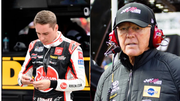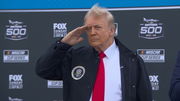
USA Today via Reuters
Nov 6, 2021; Phoenix, AZ, USA; An overall view of the track during the Xfinity Series Championship at Phoenix Raceway. Mandatory Credit: Peter Casey-USA TODAY Sports

USA Today via Reuters
Nov 6, 2021; Phoenix, AZ, USA; An overall view of the track during the Xfinity Series Championship at Phoenix Raceway. Mandatory Credit: Peter Casey-USA TODAY Sports
One of the few spoilsports in the grand showcase of speed is Mother Nature’s creation, rain, and its accompaniment of thunder and lightning. Inclement weather more often than not has the potency to alter the outcome of the race, which often leaves NASCAR drivers and its fandom furious.
However, it is not only rain that is to be solely blamed for throwing a wrench and upsetting the schedule of the race but also lightning and thunder. One may find this implausible, but believe it or not, there exists a rule termed ‘Lightning Clock’ in NASCAR’s rulebook. If a motorhead ‘did not see that coming’, it is time to delve deeper into this rule and its origin.
ADVERTISEMENT
Article continues below this ad
The tragedy that led NASCAR to implement a new rule
During a race back in 2019, a visibly frustrated Dale Earnhardt Jr tweeted, “I hope I never hear the words “lightning clock” again. @NASCAR.” Fast forwarding to the 2023 Cup Series: during the race at the Gateway, the authorities were compelled to call back the drivers to the pit road and wave the red flag. The reason: a series of lightning strikes was located within four miles of the track. As a result, the race had to be delayed for thirty minutes, owing to the ‘Lightning Clock’.
With that being said, it is time to construe what ‘The Lightning Clock’ is and how it became an indispensable part of the world of NASCAR. The origin of this rule is assuredly a tragic one, and one has to trace it back to the tragedy in 2012 that sowed the seeds for the rule. In a 2012 race at Pocono, during the race delay, a NASCAR fan lost his life, while six other people sustained heavy injuries but were deemed stable.
Watch this Story: Here’s Why Jimmie Johnson & Richard Petty Decided to Rename Petty GMS to Legacy Motor Club
This resulted in the construction of the ‘lightning clock’ rule, which stated that if a bolt of lightning struck within the 8-mile radius of the track, NASCAR would mandate a mandatory caution; the race would be red-flagged for 30 minutes, and the spectators might also be requested to leave the grandstands for personal safety.
Moreover, if subsequent lightning is accompanied, within 30 minutes of delay, the ‘lightning clock’ is reset. One may also be curious why the 8-mile radius is taken into consideration. Well, according to reports, lightning can strike as far as 10 miles, and the eight-mile radius acts as a buffer zone. The rule came into play in 2019 during the Daytona race and baffled the strategy of the teams, and it was Justin Haley, the part-time driver for Spire Motorsports, who had the last laugh after the end of the race.
Trending
Justin Haley outshines race leader Kurt Busch
The victory at Daytona marked the third win for Haley and the first for Spire Motorsports. After two lightning delays, the drivers, along with Kurt Busch, the race leader, waited until the eleventh minute for the pit stop. As a result, Busch, who pitted for fresh tires, surrendered his lead to Justin Haley, who stayed out.
After leading for one lap under caution, the race was called official after a deluge of rain stuck to the track with 33 laps left in the race. An elated Haley expressed to NBC, “It’s absolutely a blessing. It’s pretty incredible to have so many great people around me that have given me this opportunity to come to this level and the stage we’re performing on. I never even saw myself running a Cup race until I got a call a few months ago to do Talladega. It’s just unreal. I don’t know how to feel.”
It is not just NASCAR that follows the ‘lightning clock’ rule but also sports like the NFL and college football that follow the same suit but with different protocols.
ADVERTISEMENT
Article continues below this ad
ADVERTISEMENT
Article continues below this ad
With that being said, the lightning rule does come with its own set of challenges. However, there is no denying the fact that this rule asserts the importance of the audience, and nothing stands bigger than the importance of the safety of the individuals present on the track.
ADVERTISEMENT
ADVERTISEMENT
ADVERTISEMENT
ADVERTISEMENT






